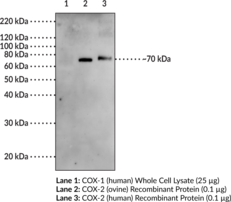Description
Myeloperoxidase (MPO) is a heme-containing enzyme and the most abundant protein in polymorphonuclear leukocytes (PMNs).{57128} It is comprised of two subunits linked by a disulfide bridge with each subunit containing a light and a heavy polypeptide chain. It can oxidize a variety of substrates and catalyzes the formation of highly reactive (pseudo)hypohalous acids and radicals, including hypochlorous acid. MPO is stored in azurophilic granules of PMNs and is released from activated or necrotic PMNs, after which it can bind to and modify acidic serum proteins, as well as recruit additional PMNs. MPO also has roles in PMN apoptosis and antimicrobial defense systems, including neutrophil extracellular traps (NETs).{57128,23608,24590} MPO-deficient mice exhibit reduced survival in a polymicrobial sepsis model, increased susceptibility to experimental autoimmune encephalomyelitis (EAE), and increased atherosclerosis in mice also deficient in the LDL receptor and fed an atherogenic diet.{57128,57129,57127} Cayman’s Myeloperoxidase Monoclonal Antibody (Clone 2C8) was developed by fusing the spleen of a non-immunized NZBWF1 mouse with a mouse myeloma cell line and can be used for immunofluorescence (IF) applications.
Synonyms: MPO
Immunogen:
Formulation: 200 µg of affinity-purified IgG2b
Isotype: IgG2b
Applications: IF
Origin:
Stability: 365 days
Application|Immunofluorescence||Product Type|Antibodies|Monoclonal Antibodies||Research Area|Cardiovascular System|Blood|Serum Proteins||Research Area|Cardiovascular System|Cardiovascular Diseases|Atherosclerosis||Research Area|Cardiovascular System|Lipids & Lipoproteins|Lipoproteins||Research Area|Cell Biology|Cell Death|Apoptosis||Research Area|Cell Biology|Cell Death|Necrosis||Research Area|Immunology & Inflammation|Autoimmunity||Research Area|Immunology & Inflammation|Innate Immunity|NETosis||Research Area|Immunology & Inflammation|Innate Immunity|Sepsis/Shock||Research Area|Infectious Disease||Research Area|Neuroscience||Research Area|Oxidative Stress & Reactive Species|Pro-oxidant Activity||Research Area|Oxidative Stress & Reactive Species|Reactive Oxygen|Myeloperoxidase


